Monday 26 February 2018

I was recently reading through Rachel Arnold's (Arnold et al, 2014) paper describing the red-fingered anglerfish, Porophryne erythrodactylus, when I realised I have pretty much seen all the colour morphs shown in the paper. It is truly remarkable how much variation there is in colour patterns in this species and also how well these colours help them camouflage with their surroundings. More...
Wednesday 21 February 2018
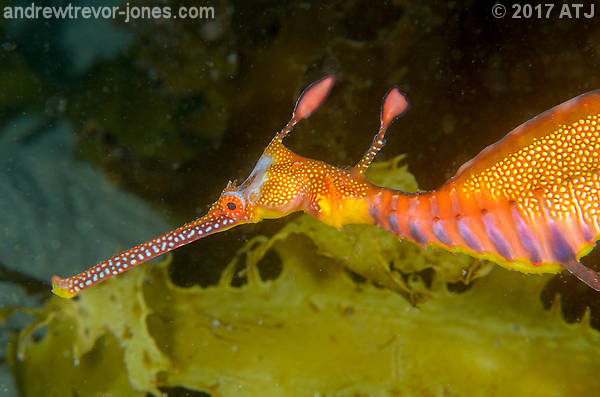
I was diving at The Leap, Kurnell on 23 September 2017 when I came across a male weedy seadragon with new eggs. Male weedy seadragons with eggs is a common sight at Kurnell in September but what was different about this seadragon was that he had quite extensive damage to his head. I don't know how the damage occurred and at the time I didn't know if he would survive. I watched him over the following months and this is his story. I have called him "Clyde". More...
Monday 19 February 2018
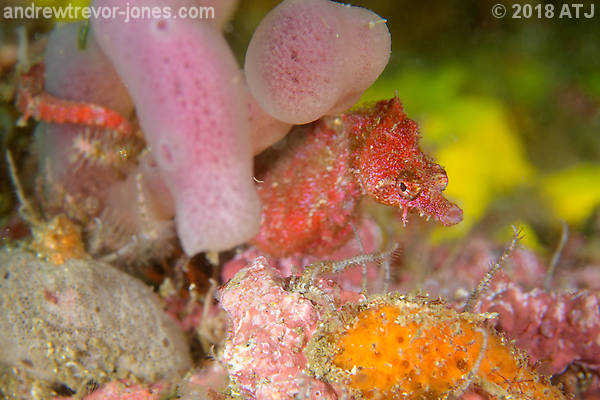
I dive. I dive often. I dive every weekend. I have dived every weekend since April 2013. I also dive on weekdays. In fact, if I'm not working I'm usually diving. You can see from my dive log just how often I dive. More...
Friday 7 July 2017

The eastern coastline of the Botany Bay National Park at Kurnell has a number dive sites. While swimming around and between the sites it is possible to see a number of individuals of Sydney pygmy pipehorses, Idiotropiscis lumnitzeri. These pygmy pipehorses tend to stay in the same place for a time and so with careful observation, the same individuals can be seen at the same locations over successive dives. They are very small and difficult to spot and this entry is likely to represent just a small proportion of individuals in the area. More...
Sunday 24 January 2016
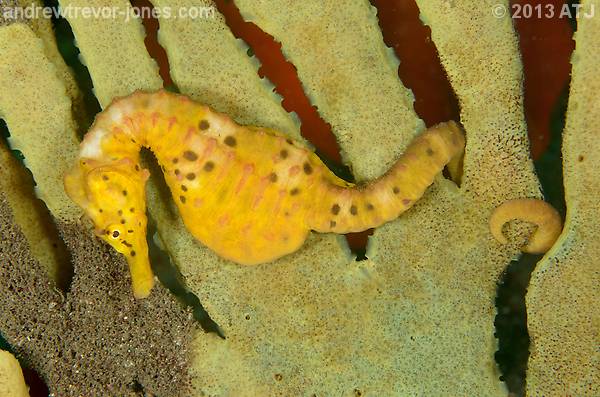
Seahorses, pipehorses, seadragons and pipefish belong to the family Syngnathidae and so are known in the scientific community as syngnathids. It sounds like a bit of a mouthful but it is generally easier to just say syngnathids rather than list the members of the family. Syngnathid is pronounced as sing-nath-id so is actually easier to say than it might look. The name means 'fused jaw' and refers to the tubular snout found in most of the species. More...
Wednesday 30 December 2015

Bare Island is a very popular diving location at La Perouse, New South Wales. The island is quite large and can't realistically be dived in a single dive - at least not if you want to see anything. There are various places around Bare Island where it is possible to see a number of individuals of Sydney pygmy pipehorses, Idiotropiscis lumnitzeri. These pygmy pipehorses tend to have a relatively small home range and so with careful observation, the same individuals can be seen at the same locations over successive dives. They are very small and difficult to spot and this entry is likely to represent just a small proportion of individuals in the area. More...
Sunday 27 December 2015

I have often wondered why white Sydney pygmy pipehorses, Idiotropiscis lumnitzeri, seem to appear as adults and I don't see them when they are small. Recently I found a drab male that over a few weeks became white. Perhaps that answers my wondering. Even more interesting was a white female that went drab over a few weeks. She had been white for a couple of months and then gradually went drab and became cryptic. More...
Tuesday 10 November 2015
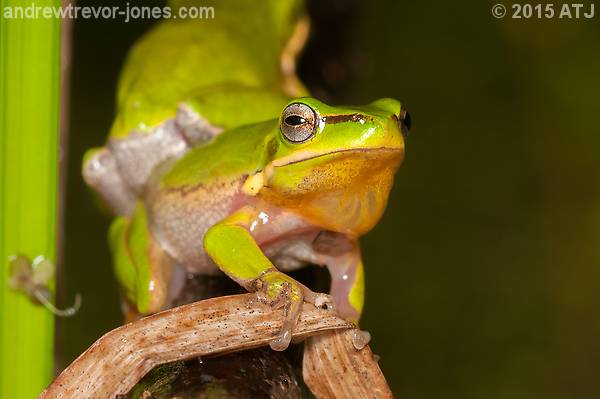
The other night while I was out photographing frogs in and around the pond I noticed two frogs interacting. I saw a male dwarf tree frog, Litoria fallax that was calling. Another dwarf tree frog started to climb over the male. They then climbed one one of the blades of the water plant clambering over each other until they reached the top and they both fell off into the water. More...
Tuesday 10 November 2015
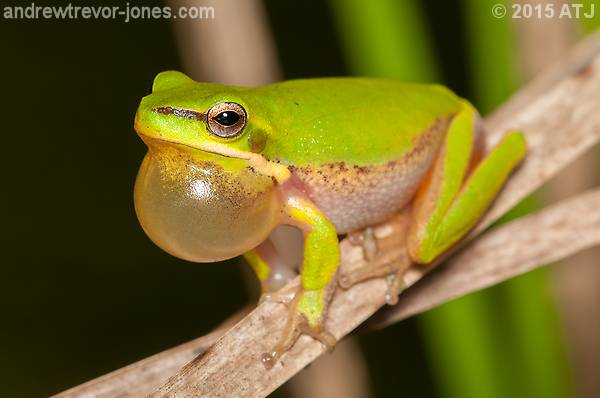
Over the last week or so I have photographed more calling frogs. Most have been dwarf tree frogs, Litoria fallax, but I have managed to get a couple of Peron's tree frogs, Litoria peronii and even a striped marsh frogs, Limnodynastes peronii. More...
Friday 6 November 2015

The eastern coastline of the Botany Bay National Park at Kurnell has a number dive sites. While swimming around and between the sites it is possible to see a number of individuals of weedy seadragons, Phyllopteryx taeniolatus. More...
Monday 2 November 2015
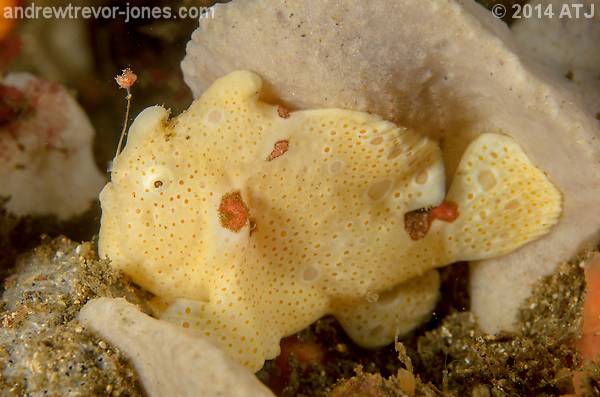
The eastern coastline of the Botany Bay National Park at Kurnell has a number dive sites. While diving around and between the sites it is possible to see a number of anglers of at least two species, painted angler, Antennarius pictus, and a recently described species, red-fingered angler, Porophryne erythrodactylus. More...
Sunday 1 November 2015
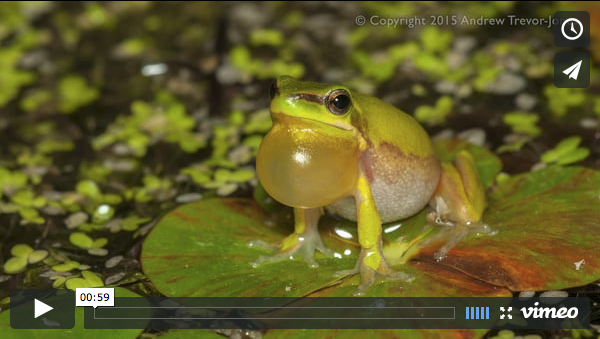
I have been very lucky to be able to photograph calling dwarf and Peron's tree frogs in the pool/pond in the backyard. Unfortunately, the photographs don't give a feel for the sounds these frogs made. I put together a video combining the calls with the photographs. More...
Saturday 31 October 2015
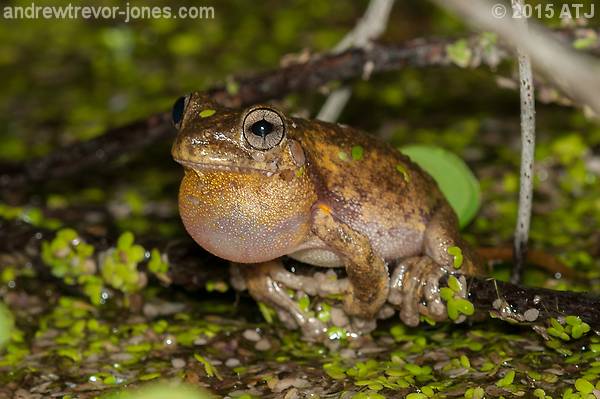
I took some more photographs of the tree frogs last night. This time I attached the monopod to the 200mm lens and folded it back towards me so I could rest it on the edge of the pool for stability. The camera was a lot more stable and it was easier to focus. More...
Friday 30 October 2015
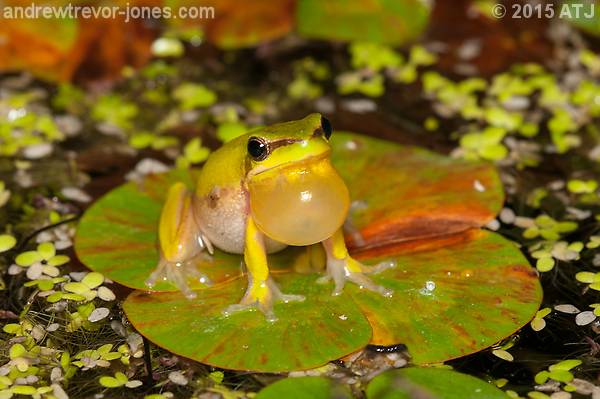
Last week we had our first green tree frog, Litoria caerulea, in the backyard, to add to the Peron's, L. peronii and dwarf, L. fallax, tree frogs. Last night I ventured into the backyard with my camera and 200m lens and found a lot of male dwarf tree frogs calling from the pool/pond. More...
Thursday 22 October 2015
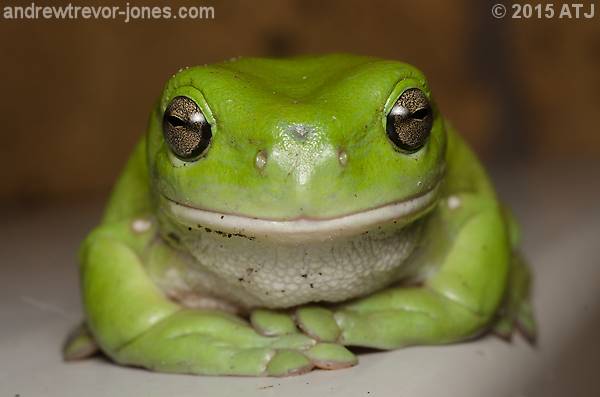
We've had Peron's tree frogs, Litoria peronii, in our backyard since we've lived here (17 years). We've had dwarf tree frogs, L. fallax, occasionally in that time, although they seem to have moved in over the last couple of years. We've never had green tree frogs, L. caerulea before. That was until last night when I spotted an almost fully grown one. More...
Tuesday 13 October 2015
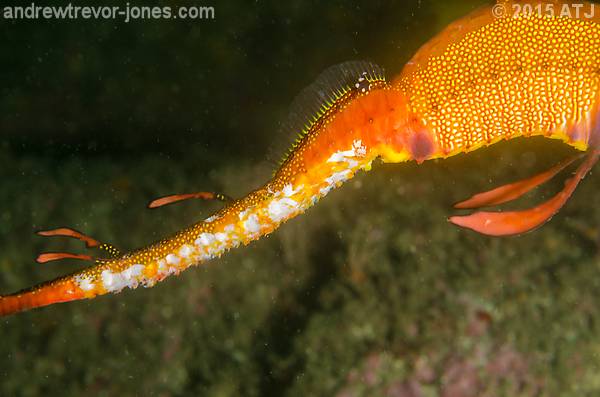
I have been observing weedy seadragons, Phyllopteryx taeniolatus at Kurnell for a number of years. I frequently see males with eggs and they usually carry the eggs until they hatch. I often see males with the remnants of the eggs for a short time after hatching. I recently saw one male who had eggs on one day but two days later not only were the eggs gone but he had marks on his tail that suggested something had eaten the eggs. More...
Tuesday 29 September 2015
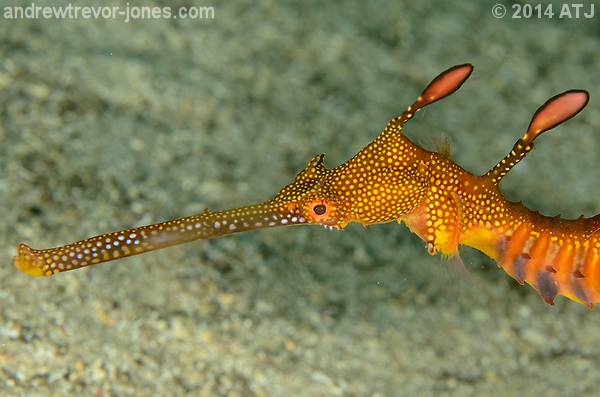
They say that a leopard can't change their spots but I think that maybe a weedy seadragon can. I had assumed that the spots on the snout of a weedy seadragon, Phyllopteryx taeniolatus, wouldn't change throughout the course of its life. I have since found an individual where the spots on one side of its snout have changed significantly over time. More...
Original: Wednesday 25 June 2014 Update: Monday 31 August 2015

Pygmy pipehorses are a group of small syngnathids (fish family Syngnathidae) that look like a cross between seahorses and pipefish. They tend to orient themselves horizontally like pipefish but they are not as elongated as pipefish and have a more seahorse look to them, especially around the head. There are 11 species of pygmy pipehorses globally with four species found in Australia of which one, Sydney's pygmy pipehorse, Idiotropiscis lumnitzeri, is found from Sydney south to Jervis Bay. More...
Original: Sunday 18 January 2015 Update: Monday 31 August 2015
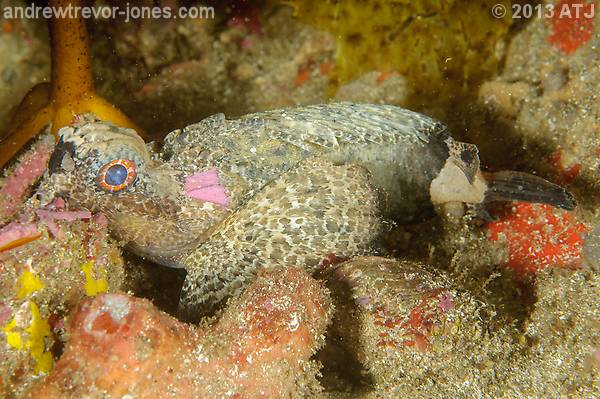
I recently completed my 100th dive at a dive site called The Leap at Kurnell and to celebrate the achievement I thought I would post why I love this site so much. I am happy to dive at The Leap every weekend. I will dive there twice on the same weekend, even twice on the one day. Why do I love it so? Read on... More...
Saturday 18 April 2015
I have a confession. I am a geek. I think I probably have always been one. I love gadgets and I love technology and automation. I don't have a lot of gadgets, but those I have I enjoy using. More...
Thursday 30 October 2014
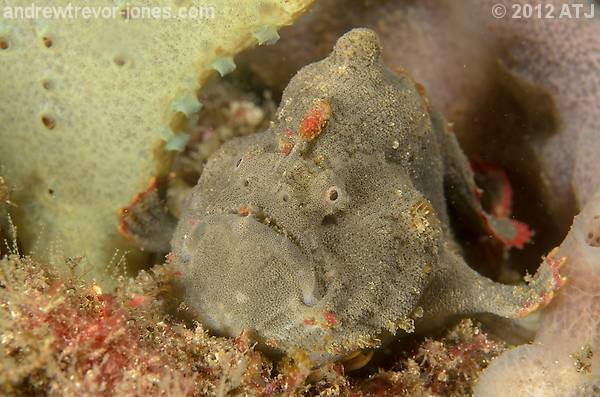
In January 2011, while diving at The Leap, Kurnell, another diver pointed out what I initially thought was a grey sponge and only on looking from a different angle did I realise she was pointing out an anglerfish. I took some photos of the angler but when looking at the photos realised it was not a species that was in any of my books. I later found out that this species has been seen around Sydney, in particular Botany Bay for a few years but was a previously undescribed species. I have seen a number of different individuals at Kurnell and Bare Island since then and have had to label them as "Undescribed angler" with no species name. That is until September 2014 when Rachel Arnold, Rob Harcourt and Theo Pietsch published a paper describing this species and giving it the name Porophryne erythrodactylus. More...
Monday 11 August 2014
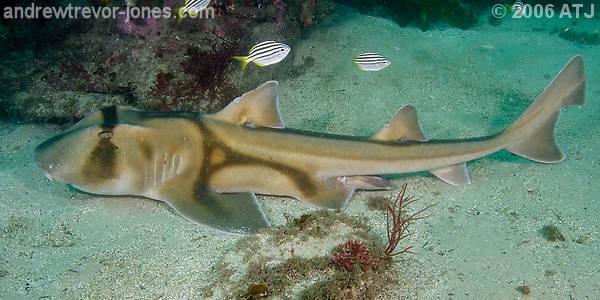
Port Jackson sharks are familiar to most divers in the Sydney area and are easy to identify - or are they? I had always been confident of correctly identifying a Port Jackson shark, Heterodontus portusjacksoni and while I was aware of a second species in the region, the crested horn shark, H. galeatus, I thought I would be able to tell them apart. After incorrectly identifying a crested horn shark as a Port Jackson shark in a recent dive log entry, Sue Newson of Crest Diving in Jervis Bay pointed out a rather simple method to tell these two species apart. Once shown this simple clue, telling them apart becomes remarkably easy. More...
Original: Thursday 29 August 2013 Update: Wednesday 6 August 2014
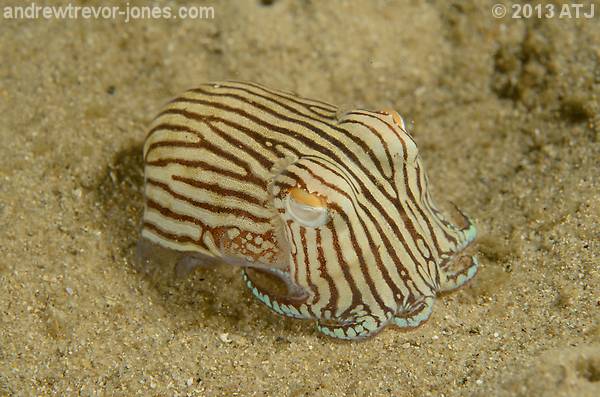
I have been fascinated by cephalopods since my mid teens. They are intelligent and their ability to change colour is amazing. I like to see different cephalopods whenever I can. One of my favourite books is A Guide to Squid, Cuttlefish and Octopuses of Australasia by Mark Norman and Amanda Reid. I can spend hours thumbing through it looking at the species I have seen and those I haven't. More...
Monday 2 June 2014
The majority of my photography is underwater using my Nikon D7000 housed in an Ikelite housing. The housing protects the camera from the water but means that it is not possible to physically get at the memory card without opening the housing. Opening the housing isn't particularly difficult but does takes some time and care to ensure that it is completely dry. If doing a single dive per weekend this is not much of an issue but when doing multiple dives or when on a dive trip where doing up to 4 dives a day, opening the housing is not practical. For the last 2 years I have been successfully transferring my photographs off the memory card while the camera is still in the housing. This means I only need to open the housing to change the camera battery and as the battery lasts for 4-5 dives I can usually go a full weekend without opening the housing or a full day on a dive trip. More...
Friday 7 February 2014
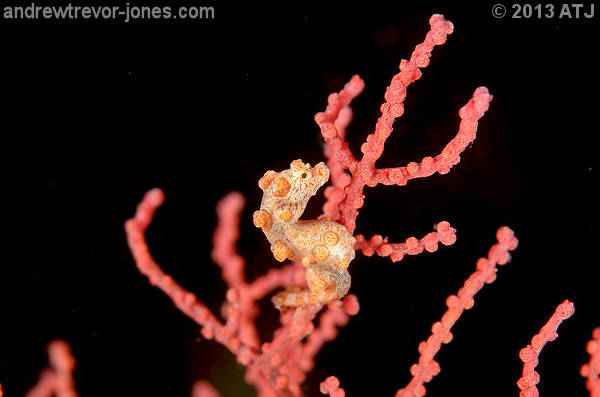
I saw my first pygmy seahorses on the Great Barrier Reef in 2006. There were a few of them on a sea fan at a secret location at a very popular dive site. The location was secret because the dive operator didn't want them to be disturbed. I saw them again - well pygmy seahorses on the same sea fan - in 2007. I did not see any pygmy seahorses again until my dive trip around Komodo Island, Indonesia, in 2012. In 2013, I travelled to Raja Ampat in eastern Indonesia and not only saw many of the more common species, Hippocampus bargibanti but also two other species: H. denise and H. pontohi. More...
Sunday 17 July 2011
I had a nasty shock yesterday afternoon while disassembling my housing when I saw some water droplets on the inside of the dome port. There wasn't a lot of water and the leak detector had not gone off - at least not that I had seen. More...
Original: Friday 6 June 2008 Update: Friday 3 June 2011
I hear stories of people losing their photographs. I also hear people asking about the best methods to backup their data. I thought people might get value from reading my backup methods, not because I think mine are the best, but simply to provide ideas for some possible methods. More...
Thursday 2 July 2009
Fluorescence is an interesting effect which we frequently see with our own eyes. Capturing fluorescence in a photograph is not always easy but with the use of a couple of filters can be achieved very effectively. The filters work simply because they follow the principles of fluorescence. In the following article I will try to explain fluorescence, with examples from corals (one of my areas of expertise) and show how to photograph the fluorescence in corals. More...
Original: Friday 6 June 2008 Update: Thursday 18 June 2009
I have three lenses that I currently use for underwater work, Nikon AF-S DX Zoom-Nikkor 18-55mm f/3.5-5.6G ED II, Nikon AF Micro-Nikkor 60mm f/2.8D and Tokina AT-X PRO DX 12-24mm f/4. Each lens has its strengths and weaknesses and each is more appropriate for certain subjects. Unlike above water photography, you can't change lenses while you are underwater, so you must choose the lens before the dive and live with it for the whole dive. Additionally, unlike above water photography, you need to minimise the amount of water between the lens and the subject so lens choice is somewhat more important. Below are my opinions of my three lenses and the sorts of dives/subjects I shoot with them. More...
Original: Sunday 9 December 2007 Update: Saturday 23 May 2009
I took a photograph of an orb weaver in the backyard on a week or so ago using the Nikon D70, Micro-Nikkor 60mm f/2.8 and Sunpak GX14 on the DIY macro bracket. I was pleased with the composition but felt the image was lacking something. I sought some advice from the folks at NatureScapes.Net and the general consensus was the lighting was too harsh and I'd be better off with a softbox to diffuse the light. I didn't have one so I thought it was time to make one to fit my Nikon Speedlight SB-24. More...
Monday 16 February 2009
The light from a bare flash can be quite harsh causing deep shadows (Figure 1). This can result in the loss of detail in highlight and/or shadow areas of an image. A softbox can be used on the flash to soften the light (Figure 2). Basically a softbox provides a translucent area onto which the light from the flash is projected. The subject is then lit by the translucent area which is much larger than the bare flash resulting in more even lighting. To date I have made 4 softboxes, excluding prototypes. I use 3 of them on a regular basis for macro photography and I carry these three in my camera backpack all the time. More...
Wednesday 14 January 2009
In mid-October, 2008, I noticed some tiny katydid nymphs in the backyard and I have been watching them grow over that last 3 months. One has finally reached adulthood and I thought this would be a good time to document their growth, especially now that I can more accurately identify the species. More...
Original: Sunday 28 December 2008 Update: Monday 12 January 2009
While walking the dogs this morning, I spied some native orchids to the side of the track. I headed back this afternoon to get some photographs. After looking more closely, I found a great number of spike and it appears there may be more than one species. More...
Wednesday 24 December 2008
My AF Micro-Nikkor 60mm f/2.8D lens allows me to get 1:1 magnification when focused to its closest distance. This is great for many subjects but subjects less than around 20 millimetres in length end up being too small in the frame. I've had a Nikon PK-13 tube for over 12 years but one of the drawbacks with the tube is that there is no CPU linkage and autofocus is lost. I recently borrowed a set of Kenko extension tubes from a friend and have been having a lot of fun using them. More...
Sunday 21 December 2008
My usual technique for shooting macro on the monopod is to have the camera on manual focus, set the focus point and then rock the camera forward or back until the desired part of the image (e.g. the eyes on a spider) are in focus. The monopod means I can hold the camera fairly steady with just my right hand. This frees my left hand for holding foliage out of the way or even steadying the foliage, particularly if there is wind around. The problem I have when holding foliage with my left hand is I have no way to adjust the focus if I want to move closer to fill the frame more or further away because the subject changed its angle. I have recently discovered that I can use the AF-ON button on my Nikon D300 to make focus adjustments but still use my manual focus technique for the actual focusing. More...
Friday 31 October 2008
In February 2008, I was introduced to Lightroom by a friend. Almost immediately, I realised this was a great improvement to my post processing workflow, but I was frustrated by the initial raw conversion (as have been a lot of other users). When Lightroom 2.0 was released, Adobe also introduced beta versions of prebuilt camera profiles for use with Adobe Camera Raw (ACR) which is used by Lightroom and Photoshop. The profiles were well received but my own testing left me disappointed. After much experimentation and asking lots of questions I determined why my results weren't good and now I find the profiles very useful. More...
Tuesday 7 October 2008
Last Sunday I went for a dive at The Steps at Kurnell. The site is named for the steep steps you have to descend from the car park to the water's edge. The site is just around the corner from The Monument. More...
Sunday 28 September 2008
I received a Jeff Mullins' Underwater Leak Detector just before I went away on my Undersea trip (only just in time, too) and have not had a chance to write about it. I used it for the 13 dives and one snorkel and I had no problems at all. I guess this is one purchase I hope I never have to find out if it works. More...
Saturday 27 September 2008
In August I went on my sixth trip on Undersea Explorer. These trips provide fantastic photographic opportunities with subjects ranging from whales (if we're lucky) all the way down to tiny nudibranchs. On previous trips I have taken more than two thousand photographs over 20-22 dives. Unfortunately for this trip, I came down with the 'flu a few days before the start of the trip and didn't recover in time. Out of a possible 21 dives, I only completed 13 with less than one thousand photographs which was disappointing. Despite the 'flu, I did manage to get some pleasing photographs. More...
Saturday 27 September 2008
Nikon digital SLR cameras internally store the total number of shutter releases for the camera. This information is then included in the Exif data embedded in each image taken with the camera. The total number of shutter releases is useful to know especially when buying or selling a camera but is also a handy piece of information if you want to get an approximation for the number of photographs taken. More...
Original: Saturday 29 March 2008 Update: Friday 19 September 2008
Since starting to use Adobe Lightroom, I have found a number of occasions where I am unable to manipulate a Nikon raw file (NEF) to my satisfaction using Lightroom's raw converter. In these cases, Nikon's CaptureNX does a much better job and so I needed a way to simply launch CaptureNX from Lightroom when required. The problem with Lightroom is that it assumes that any external editor can't do the raw conversion and so converts the raw file to a standard format such as TIFF and launches the editor with that file. This means that I don't get the benefits of the raw conversion in CaptureNX. I devised a workaround which works quite well. More...
Thursday 7 August 2008
While investigating geotagging and GPS loggers for my above water photographs I stumbled on a novel idea for my underwater photographs. While GPS doesn't really work underwater, I can use the GPS altitude field to store the depth of each photograph and set the latitude and longitude to a specific location for all the photographs. More...
Sunday 6 July 2008
After a month of poor weather, I finally got to go for a dive yesterday. The dive was at Shiprock on Port Hacking, which is a very popular dive site, well protected from rough seas. I remember doing a night dive there some time in the early 1980s but don't know exactly when as I don't have it logged. More...
Thursday 19 June 2008
I have had a minor annoyance with the design of the tray handle that came with the housings for both the D70 and the D300. No matter how much I tighten the mounting bolts, there is always a certain amount of movement between the tray and the housing. After thinking about it for over 12 months, I finally did something about it last night and made some spacers out of aluminium. More...
Friday 6 June 2008
I have three lenses that I currently use for underwater work, Nikon AF-S DX Zoom-Nikkor 18-55mm f/3.5-5.6G ED II, Nikon AF Micro-Nikkor 60mm f/2.8D and Tokina AT-X PRO DX 12-24mm f/4. Each lens has its strengths and weaknesses and each is more appropriate for certain subjects. Unlike above water photography, you can't change lenses while you are underwater, so you must choose the lens before the dive and live with it for the whole dive. Additionally, unlike above water photography, you need to minimise the amount of water between the lens and the subject so lens choice is somewhat more important. Below are my opinions of my three lenses and the sorts of dives/subjects I shoot with them. More...
Friday 6 June 2008
I hear stories of people losing their photographs. I also hear people asking about the best methods to backup their data. I thought people might get value from reading my backup methods, not because I think mine are the best, but simply to provide ideas for some possible methods. More...
Wednesday 28 May 2008
When I publish my dive photographs, I like to include an approximation of the depth at which the photographs were taken. I can do this because the camera records the time a photograph was taken and my dive watch and dive computer log their depth at 5 second intervals. Combining this information allows me to determine the depth. More...
Monday 26 May 2008
I have done a few dives of late with my Nikon D300 in the Ikelite Housing. I'm pretty happy with rig and getting better at using it with each dive. While I still prefer the Nikkor 18-55mm for its flexibility, especially when the potential subjects at a site are not known, I just love the results from the Micro-Nikkor 60mm f/2.8 in the flat port. I haven't yet done enough dives with the Tokina 12-24mm to know if I like it yet. More...
Monday 14 April 2008
On Sunday I dived at The Monument at Kurnell with some folk from St George Underwater Centre. This was my fifth dive with the D300. I was expecting a mixture of subjects so I took the 18-55mm lens in dome port to give me some flexibility. More...
Friday 11 April 2008
In mid-February a friend provided a demonstration of Adobe Photoshop Lightroom. I was quite impressed and thought I would evaluate the product to replace my current workflow. It has been an interesting experience and I have to say it is not an easy tool to pick up. More...
Friday 11 April 2008
While walking the dogs through Mount Sion Park yesterday afternoon, I noticed a large golden orb weaver, Nephila sp. just off the path. On today's walk, I took the D300, 60mm lens, SB800 flash with collapsable softbox and monopod and got some nice shots. More...
Saturday 29 March 2008
Since starting to use Adobe Lightroom, I have found a number of occasions where I am unable to manipulate a Nikon raw file (NEF) to my satisfaction using Lightroom's raw converter. In these cases, Nikon's CaptureNX does a much better job and so I needed a way to simply launch CaptureNX from Lightroom when required. The problem with Lightroom is that it assumes that any external editor can't do the raw conversion and so converts the raw file to a standard format such as TIFF and launches the editor with that file. This means that I don't get the benefits of the raw conversion in CaptureNX. I devised a workaround which works quite well. More...
Tuesday 18 March 2008
Last Sunday I went for a dive at Oak Park, Cronulla with Tim Everest and Colin Keene. This was my fourth dive with the D300 in its Ikelite Housing. More...
Tuesday 11 March 2008
In December 2007, I made a softbox for use with my flash. It has worked extremely well and I have got some great photographs with nice soft lighting. The problem with the softbox is the shape means it is not easy to carry around (other than in use). After thinking about it for a while I realised it would be fairly easy to make a collapsable version which will squash flat and can easily fit into my pack. More...
Monday 11 February 2008
I have had my Nikon D300 for a couple of months and I now have an underwater housing for it. I have used the housing on one dive so far and am reasonably happy with the results. More...
Thursday 24 January 2008
After 4 weeks of trying, I finally got accepted as a contributor on Alamy. Note that this doesn't mean they (or I) think that I'm a great photographer. I think it is more to do with me working out the tricks for getting accepted. More...
Tuesday 15 January 2008
I have noticed a few hits to my site from people looking for information on resetting the file sequence number on a Nikon D300. I suspect they made the same mistake as I made when they got their new cameras. I will document it here in this article so they don't have to wade through my D300 one. More...
Tuesday 18 December 2007
It has been nearly 3 years since I bought my first digital SLR, the D70. The camera has served me well with some 14.5 thousand shutter actuations. I have used it both above and below water and while I only have a few complaints, it was time to upgrade. At the time the D300 was announced, I was already contemplating an upgrade. Once I saw the specifications for the D300, I knew I had to have one. More...
Tuesday 11 December 2007
I bought my Nikon SB-24 flash in 1991 when I bought my F-801s. The flash has served me well for over 16 years but I do miss the TTL exposure control that I had with the film cameras and I have been using it with the D70 in manual mode. I thought it was time to get a SB-800 and so I bought one. More...
Sunday 9 December 2007
I took a photograph of an orb weaver in the backyard on a week or so ago using the Nikon D70, Micro-Nikkor 60mm f/2.8 and Sunpak GX14 on the DIY macro bracket. I was pleased with the composition but felt the image was lacking something. I sought some advice from the folks at NatureScapes.Net and the general consensus was the lighting was too harsh and I'd be better off with a softbox to diffuse the light. I didn't have one so I thought it was time to make one to fit my Nikon Speedlight SB-24. More...
Saturday 1 December 2007
I have decided to start a blog so I can share ideas, experiences and other information that I hope will be relevant to some readers. The frequency of the blog articles will depend on my available time as well as the number of interesting ideas I have. More...